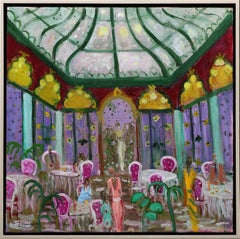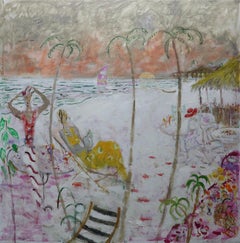Paloma Hinojosa
2010s Neo-Expressionist Landscape Paintings
Canvas, Oil
2010s Neo-Expressionist Landscape Paintings
Canvas, Oil
2010s Neo-Expressionist Interior Paintings
Canvas, Oil
2010s Neo-Expressionist Landscape Paintings
Canvas, Oil
2010s Neo-Expressionist Landscape Paintings
Canvas, Oil
A Close Look at Neo-expressionist Art
A resurgence of interest in Expressionism, Pop art, Surrealism, Abstract Expressionism and other movements gained steam among artists of the 1970s and ’80s, in part as a reaction to the austerity of the prevailing minimalism and Conceptual art of the era. A decadent, bold and brash art style called Neo-Expressionism saw painters returning to figural representation, creating highly textured works that were imbued with intensely personal narratives.
Neo-Expressionist paintings are sensuous in nature and highly subjective in meaning. Expressive brushwork, highly pigmented colors and layered forms and materials lent sculptural attributes to the work and were used to depict symbolic narratives from history, mythology and the artist’s personal experience.
Prominent figures such as Jean-Michel Basquiat led the Neo-Expressionist movement in the United States with paintings and prints that were raw, emotional and often violent in nature. In Germany, Die Neuen Wilden (the “New Fauves”) was the name given to a group of postwar artists that included the likes of sculptor Georg Baselitz and Gerhard Richter, a painter and photographer who explored the possibilities of both abstraction and realism, sometimes in a single piece. The work of the New Fauves — labeled as such for its return to Fauvism’s textured brushwork and use of vibrant colors — shares commonalities with Neo-Expressionism, and Baselitz was a pioneer of the movement in Europe. In addition, Willem de Kooning’s pulsating action paintings and Julian Schnabel’s experimentation with the materiality of paintings also took shape during this period.
“I was trying to make paintings different from the paintings that I saw a lot of at the time, which were mostly minimal, and they were highbrow and alienating, and I wanted to make very direct paintings that most people would feel the emotion behind when they saw them,” said Basquiat.
Neo-Expressionism generated some polarizing opinions, with some celebrating the revival of personal subjectivity in art while others criticizing the movement for being too commercially driven and nostalgic. But most experts agree that Neo-Expressionism was a huge commercial success and culturally impactful, paving the way for the postmodern work of artists like Richter and Sigmar Polke.
Find original Neo-Expressionist paintings, prints, mixed-media works and other art on 1stDibs.
Finding the Right Landscape-paintings for You
It could be argued that cave walls were the canvases for the world’s first landscape paintings, which depict and elevate natural scenery through art, but there is a richer history to consider.
The Netherlands was home to landscapes as a major theme in painting as early as the 1500s, and ink-on-silk paintings in China featured mountains and large bodies of water as far back as the third century. Greeks created vast wall paintings that depicted landscapes and grandiose garden scenes, while in the late 15th century and early 16th century, landscapes were increasingly the subject of watercolor works by the likes of Leonardo da Vinci and Fra Bartolomeo.
The popularity of religious paintings eventually declined altogether, and by the early 19th century, painters of classical landscapes took to painting out-of-doors (plein-air painting). Paintings of natural scenery were increasingly realistic but romanticized too. Into the 20th century, landscapes remained a major theme for many artists, and while the term “landscape painting” may call to mind images of lush, grassy fields and open seascapes, the genre is characterized by more variety, colors and diverse styles than you may think. Painters working in the photorealist style of landscape painting, for example, seek to create works so lifelike that you may confuse their paint for camera pixels. But if you’re shopping for art to outfit an important room, the work needs to be something with a bit of gravitas (and the right frame is important, too).
Adding a landscape painting to your home can introduce peace and serenity within the confines of your own space. (Some may think of it as an aspirational window of sorts rather than a canvas.) Abstract landscape paintings by the likes of Korean painter Seungyoon Choi or Georgia-based artist Katherine Sandoz, on the other hand, bring pops of color and movement into a room. These landscapes refuse to serve as a background. Elsewhere, Adam Straus’s technology-inspired paintings highlight how our extreme involvement with our devices has removed us from the glory of the world around us. Influenced by modern life and steeped in social commentary, Straus’s landscape paintings make us see our surroundings anew.
Whether you’re seeking works by the world’s most notable names or those authored by underground legends, find a vast collection of landscape paintings on 1stDibs.

